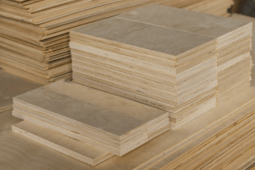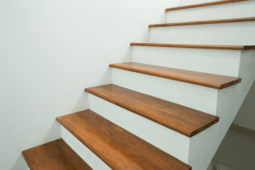What is a Yurt? 11 Best Yurts Available
Whether camping or traveling, there are any number of ways to relax. Tents are one of the most common ways, but they don’t exactly offer all of the most modern comforts available. The yurt, however, is becoming a popular option.
A yurt is a round tent that is portable and covered with either felt or skin. It can be used while traveling, though it is also used as a dwelling by some nomadic groups. There are several yurts available that can be used as a temporary or a permanent dwelling.
What is a Yurt?
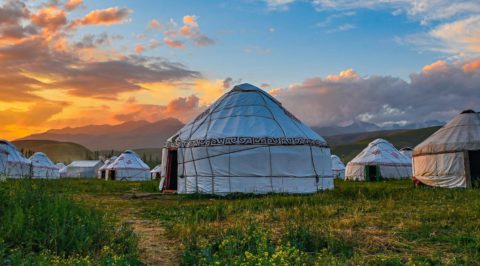
Consider the yurt to be the ancient version of today’s tent. They have been traditionally used by the more nomadic tribes that moved across Central Asia. They were initially designed to be dismantled easily, especially when the community would need to move from place to place. They are also one of the oldest forms of shelter used by ancient civilizations and are used today, though with some deviations.
The yurt is assembled in much the same way as a tent, though they are circular in structure. They are sturdily built and can make for more than adequate structures even in extreme weather conditions. They are typically made from all-natural materials; this helps them to maintain a small carbon footprint as well.
The circular shape helps to provide more internal space, especially when compared to the number of building materials that are required in its construction.
Though they are thought of traditionally as shelters, they have been since purposed to be restaurants, glamping sites, and even modern offices. They are also becoming a popular option among the tiny home community because of the improved interior space.
There are even some national parks and campsites that offer yurt rentals for anyone who wants to try them. It is a good way to bring the inhabitants closer to the earth, and they are also generally used by retreat centers as part of the spiritual practices. This includes things like sweat lodges.
History of the Yurt
The Yurt spans back centuries, going back to the nomadic people of the Eurasian Steppe. The Steppe spans from Hungary to China in distance. It is believed that the yurt goes back as far as three thousand years, with usage across different cultures (and different names accompanying them). In Russia, they are known as “yurta”, though they go by “ger” in Mongolia.
Despite different cultures calling them by different names, the meaning is the same. The translation is basically ‘home’, ‘homeland’, or ‘kinsman’ in the English language.
The structures themselves, however, are closely linked to those aforementioned nomadic people as they most traditionally inhabited them. These same people are also the heaviest inspiration behind the word ‘nomad.’ The original word stems from the word ‘felt’ – the material generally used for yurts. Because of this, nomads/yurt dwellers became known as ‘felt people.’
The circular tent is most iconic because of Mongolian nomads. The Mongolian leader, Genghis Khan, ruled his empire while making a yurt his home. Even today, many Mongolian people still make yurts their home. Nearly 61% of the capital of Ulaanbatar uses gers, while 90% of the rural population does as well.
The yurt was introduced to the United States back in the 1960s, thanks to William Coperthwaite. He introduced the country to them after reading an article about them in National Geographic in 1962. Since then, they have been featured in publications like The Whole Earth Catalog, which offers the yurt as a cost-efficient DIY way of living. Pacific Yurts became the first modern yurt manufacturer in North America when it was founded back in 1978.
How are Yurts Constructed?
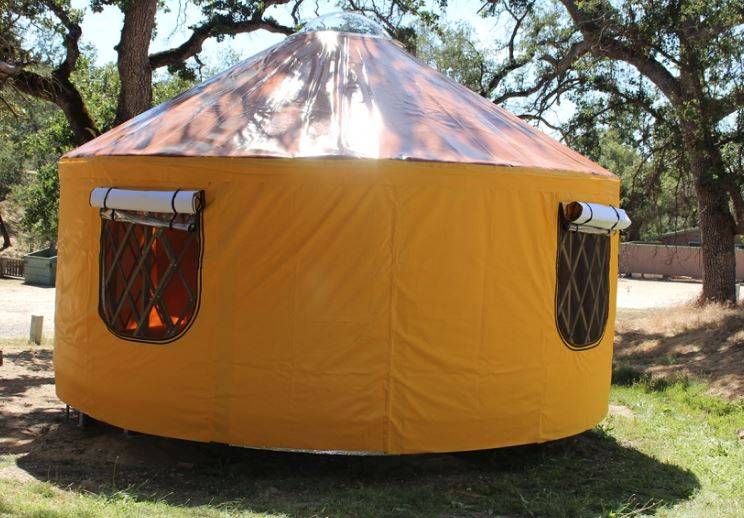
Yurts are traditionally made with a collapsible wooden frame that has been covered with wool felt. The door frame, meanwhile, offers the ability to hang a wooden door. They generally use flexible wooden poles that are made from willow, birch, bamboo, or poplar and are both woven and bound together in order to form lattice walls.
During the nomad periods, both animal hair and leather were used regularly in order to bind those poles together. The lattice usually has a series of sections that have interwoven, collapsible wooden poles known as khana.
When the frame has been built, the fabric then goes over the top of the entire structure. Traditional yurts used the aforementioned animal hides, or wool felt, usually topped with some kind of waterproof material. Today’s modern coverings, however, include things like canvas and a tarp.
For felt wool, it is often pressed together rather than woven, which gives the yurt far better insulation than normal. With a few layers of felt, you could increase the level of insulation, making it far better suited to handle outside temperatures.
The cool thing about yurts is that they can be built in different sizes. Having said that, the average yurt features walls that are roughly six feet high. Of course, the domed roof will give you another three feet or so of total height to the overall structure.
The average wooden yurt makes it quite easy to fit even normal-sized beds, though it is more common to find bunk beds for camping site yurts.
Some of the more traditional yurts will have a chimney as well as a wood-burning stove right in the middle of the living space. The chimney pokes up through a hole in the roof meant to accommodate it. The central part of the roof is known as the crown, and the more smoke stains on the crown are believed to dictate how long that family’s heritage will be according to Mongolian culture.
The crown of the yurt is left open partially in order to allow for air circulation. The other poles that make up the roof are radial rafters, who are connected to the circular structure as the tent is being constructed. Some poles, called bagana, are used to support the crown, particularly in larger yurts.
Yurts that don’t have bagana are more self-supporting, held together with ropes that are tied to the poles. There is compression involved that comes from the weight of the felt. There is also a weight that can be hung from the center to add compression to the roof cover.
Yurts also generally come in one of two styles: Mongolian gers and bentwood yurts. The latter are typically constructed using straight poles, which are then attached to the crown. The roof also has a gentle slope to it.
Bentwood yurts, on the other hand, have roofs that are made from bent wood. They have wooden poles attached to the roof that are steamed and then bent before they are ultimately attached to the crown itself. These poles also extend down in order to form a part of the walls. This provides a steeper, taller, conical-like roof. You may also hear this type of yurt referred to as Turkic yurts.
A lot of the modern yurts that are found in North America will come in three different types: a frame panel yurt (designed by David Raitt), the tapered wall yurt (designed by William Coperthwaite), and the traditional fabric yurt.
The latter two are meant to be permanent structures, often times built with foundations. These are known as yurt derivations since they aren’t transportable. They do maintain the traditional style and look that a Mongolian yurt would provide.
Modern vs Traditional Yurts
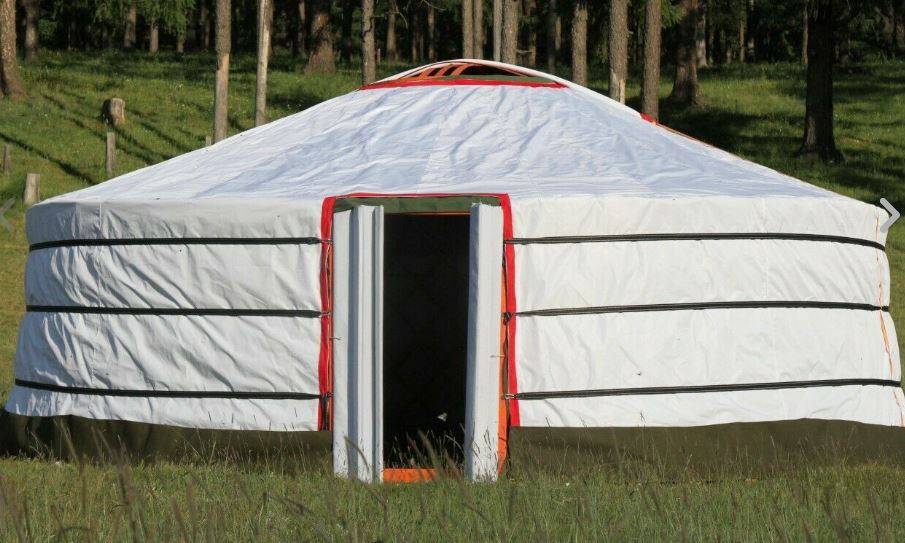
Though there are different styles of yurt available, the debate generally comes down to modern versus traditional. Knowing the difference between the two can help you decide which style makes the most sense for you.
Traditional Yurts
The structure of yurts has changed throughout the years. The traditional yurt featured straight roof pools, thick, adorned doors, and heavy center rings to provide optimal durability and stability to the structure. There are also interior support poles that add to the structural stability.
Another major difference is the material used to provide the coverings. In ancient times, animal fur or hair would be used for this purpose. In modern times, felt or another material would be used in place of animal fur.
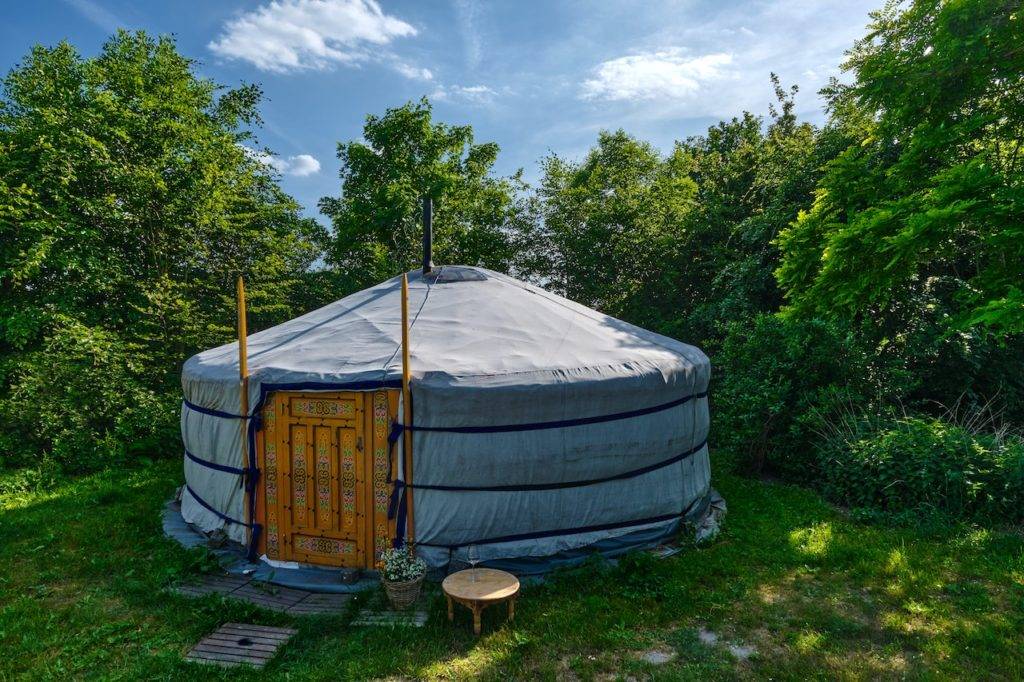
Much like the modern versions, the traditional yurts would have lattice walls and featured a tension band that would run near the top of the wall. That tension band creates a downward pressure which makes for a durable, stable, strong structure.
Then there is the crown. In Mongolian culture, the crown would be passed down from father to son. Some of the long-established families would point to the smoke stains on the crown to show the endurance of their clan. An opening could be made in the crown to allow smoke to exit while letting in natural light.
Typically, the aforementioned lattice work would be done with birch, poplar saplings, or willow; all fastened together with the use of leather thongs. They were made in sections, lashing together everything when the yurt would be assembled.
Modern Yurts
Modern yurts have a few key architectural changes compared to the traditional yurt. One of those is a central ring that has a dome skylight that can be opened. Windows are also one more modern addition to the traditional yurt. Some of them can even feature glass windows that have been insulated.
Modern yurts also make use of more durable high-tech fabric used for architectural purposes; this takes the place of the more traditional felted wood. Modern yurt covers also tend to last for a long, long time, a decade or more in some places. Modern yurts are also capable of having more modern door options like fiberglass or even French doors.
While the traditional yurt was very strong, especially given the availability of certain materials, modern yurts are even stronger than that. There are even some structural upgrades that can be added to help stand up against extreme weather conditions.
There is also the customization that is involved with modern yurts. Most modern yurts don’t have a central column, but one can be added to help add snow load capacity. Water catchments or gutters can be added, and even fan support for improved circulation.
The main difference is that the modern yurt isn’t built with transportation in mind. Modern yurts tend to be built onto some sort of foundation, many times a wood platform. Modern yurts can also include electricity, plumbing, cooling, and heating as well.
The final difference is the level of customization involved. Traditional yurts are very straightforward in their purpose, while the modern version is much more flexible to the needs of the owner. Contractors are able to add lighting, modern appliances, interior walls, and even lofts to some yurts.
The 11 Best Yurts Available in 2022
The type of yurt that works best for you depends on what you are looking to do. They are quite popular for camping, allowing for a more luxurious feel than traditional tent camping. But that is not their only use.
Yurts are becoming more and more popular within the tiny home community as well. They offer the opportunity for greater efficiency when resisting temperature changes and can offer more luxurious features than some of the other tiny homes out there.
To cover all the bases, there are more than a few worth checking out. Here are some of the best yurts that you can find in 2022
1.) Big Sky Yurt – Shelter Designs
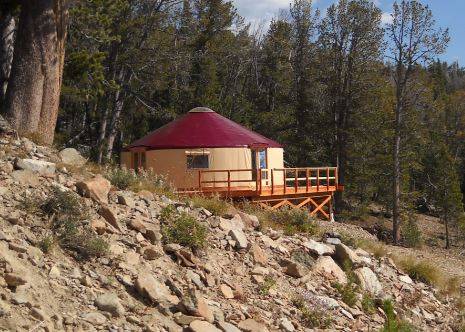
The Big Sky may be the best combination of luxury and flexibility out there today. What makes it even more desirable is the fact that the price is so flexible. These are customizable yurts that range anywhere from 12’ to a whopping 40’.
The standard features come with large Douglas Fir roof rafters and window/snow legs that are meant to stand up to the most inclement weather. Roof dimensions can be customized to give you more internal space, perfect for a tiny home that has room to host.
You could spend all day looking through the various customizable features that come with this yurt. This truly is a create-your-own-yurt, and there is even a helpful calculator to find out what your dream yurt would cost.
2.) Kestrel Yurt – Rainier Outdoor
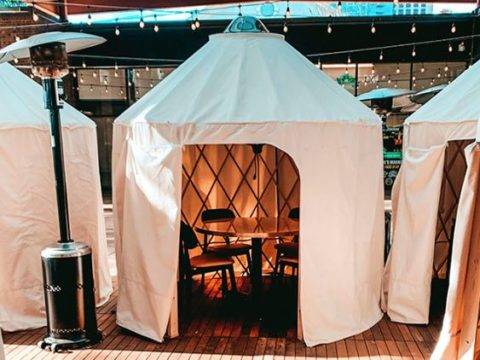
One of the simplest yet most effective yurts out on the market. It is also one of the most cost-effective, coming in at just under $3,000, depending on what size you choose. Sizes range between 8’ and 16’ feet, allowing you to create the most optimal space possible, depending on your need.
The simple felt design allows for optimal efficiency, keeping you comfortable no matter what time of year. It can be used as a backyard playhouse, a home office or workout studio, a guest room, or as a great tiny living space for extended camping trips.
Despite the relatively small size compared to some of the other yurts on the list, this one provides perhaps the greatest flexibility. There are a few limitations on where you can bring this yurt.
3.) 24’ Yurt – Colorado Yurt
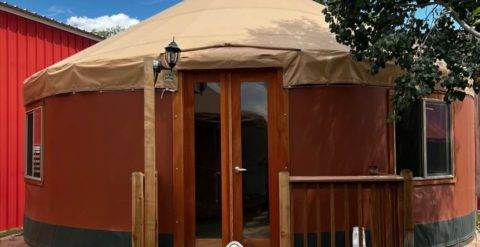
Contrary to popular belief, you don’t have to build a brand-new yurt. There are plenty of used options out there, and Colorado Yurt has some of the best-used yurts on the market today. Starting with the 24’ yurt option.
There are plenty of walls included, which can be used for both a bathroom and bedroom. There is the option for French doors, insulation, a stove, even electrical wiring, and a deck. It has all the capabilities of being a comfortable space, whether for temporary or permanent use.
Just keep in mind that models like these don’t include things like countertops or a sink, air conditioning, and some of the other customizations that can elevate the level of comfort and luxury to be experienced.
4.) 12’ Wall Yurt Cabin – Freedom Yurt Cabins
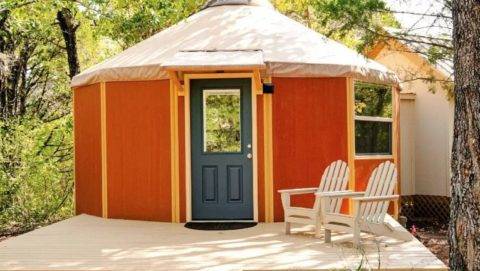
Freedom is one of the premier names in yurt cabins, and with good reason. Part of the reason is that they have a wide array of options to choose from, allowing you to get a fully customized yurt to meet your tiny home living needs.
This option covers roughly 217 square feet, offering a pair of windows and a 4’ roof dome that allows for a roughly 10’ peak ceiling height. Even as one of the smallest options, there is still plenty of room available for customization without feeling like things are ever “tight.”
It offers a tongue and groove look that has made log cabins so popular. That said, it has been built for strength and the assembly is as easy as it gets thanks to the built-in floor system as well as the design that is bolt-together.
5.) 30’ Yurt – Pacific Yurts
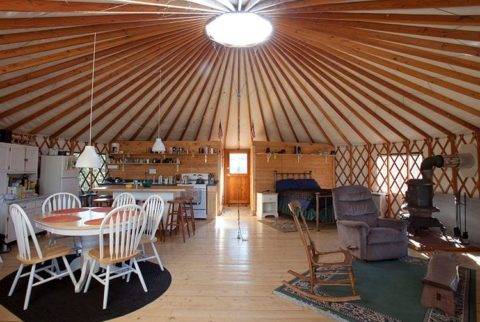
Pacific Yurts is one of the most recognizable names in the space, and with good reason. One look at their massive 30’ yurt, and you will see why so many choose to go the route of a yurt for optimal luxury living.
With a whopping 700 square feet, not to mention an even larger feel thanks to the high ceilings, there is more than enough space to fit standard living features like furniture and more. The dome skylight is a beautiful feature that allows tons of natural light as well.
There are so many options that can be added to the 30’ option that it would take too long to list. But everything that comes included is more than enough to make your living experience one that is the best of both worlds between reliability and comfort.
6.) 16’ Wall Yurt Cabin – Freedom Yurt Cabins
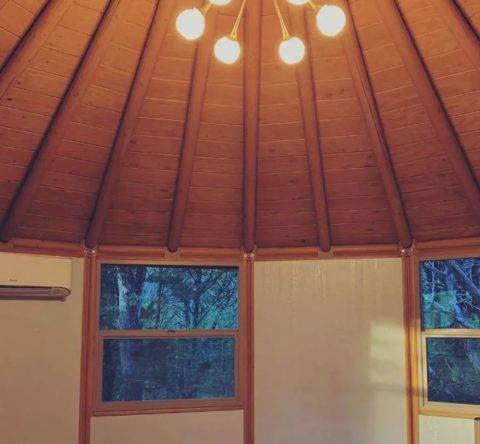
The Freedom Yurt Cabin is going to make a few appearances on this list, and with good reason. The bigger they get, the more room there is for customizable features to be added. With the sturdy construction, it is one of the favorite options on the market.
This is one of the smaller units for full-time living, though it doesn’t require decking or permanent cement like most of the other yurt installations that you will find out there. Additionally, the 16’ option is one of the most eco-friendly out there, allowing you to leave behind a minimal environmental footprint.
Even better, at this size, you can start to see accommodations for things like a kitchen, living area, bathroom, and bedroom to provide the coziest of living spaces possible.
7.) Raven Yurt – Rainier Outdoor
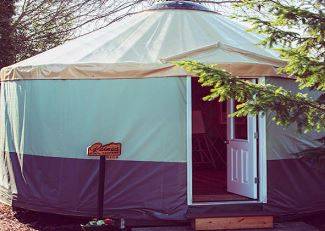
When it comes to finding a rugged option among the different yurts out there, the Raven is hard to match. It doesn’t have some of the most luxurious features out there, but its simplicity and economical design allow it to be sturdy and offer premium design at a price that doesn’t scream “premium.”
This yurt is perfect for travel, taking it to campsites, churches, state parks, or for posting up right in your own backyard. It is also able to conform to building code specifications if you want to turn it into a livable space or a vacation rental option that is made available to the public.
The utmost versatility as well, considering you can get it in sizes ranging from 16’ to 30’ in diameter, allowing you to get the perfect size for your needs.
8.) 18’ Wall Yurt Cabin – Freedom Yurt Cabins
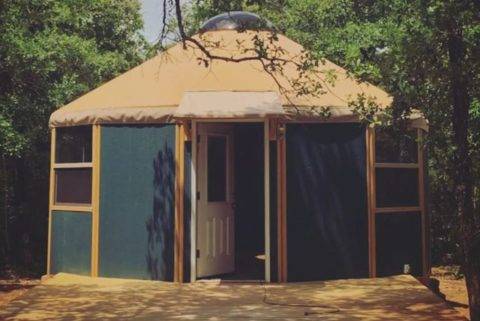
The last of the entries on this list from Freedom Yurt Cabins, but perhaps it’s best. With almost 500 square feet and a ceiling height of roughly 13’, there is more than enough room for full-time tiny home living. Even better, the interior walls can accommodate a loft, allowing for even more living space than some of the other yurts out there.
This option also features real insulation throughout, which makes it easy to keep warm even when the winter is at its coldest, all with one heat source. There are also four windows available on this unit, allowing for more natural light than many of the other yurts on the market.
Then there are the upgrades. There is an option for a screen or storm door, extra windows, floor insulation, fan mounting, and even custom color choices. All so that you can create the yurt that is perfect for you.
9.) Standard Yurt – Yurtz by Design
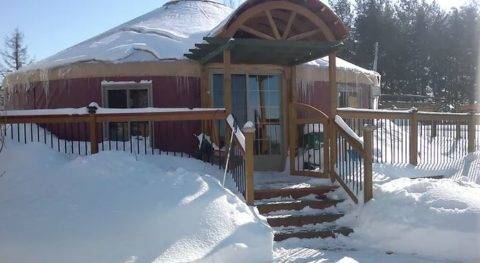
Not every yurt out there has to be totally customized. There are plenty of options out there to be had that offer great stability, reliability, and luxury living in the standard package. This offering from Yurtz by Design is a great example.
Each yurt comes in a standard 7-foot height, each featuring an open dome with a telescopic, stainless steel handle. Frames are constructed with fine-quality Douglas fir, and the hardware is all a beautiful stainless steel that really pops.
10.) Eco Yurt – Shelter Designs
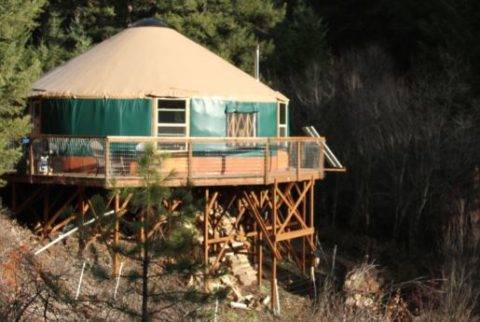
Many who look into having a yurt of their own built want to keep eco-impact in mind. After all, part of the attraction of yurt living involves being close to nature, and the last thing anyone wants to do is make their environmental impact larger.
With hand-crafted, one-of-a-kind beauty, this affordable and customizable yurt is crafted to leave a small ecological footprint. This is done through the use of a small diameter lodgepole that has ben strategically thinned to ensure that your impact is a small one.
Even with this eco-consciousness in mind, there are floorplans available up to 30’, meaning there is no need to sacrifice size for efficiency. The finishes are even safe, utilizing non-VOC options to ensure that your yurt is safe for the environment in every possible way.
11.) Eagle Yurt – Rainier Outdoor
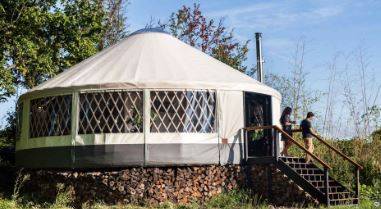
There is a lot to like about the Eagle yurt. For starters, the eagle is meant to represent power, strength, and safety in Northwest legend. This yurt is definitely true to that namesake thanks to features that promote quality and make it one of the safest, most attractive, and sturdiest yurts out there.
There are a ton of customizable and upgradeable options; the only limits are your imagination and budget. It also offers great flexibility that can meet just about any needs you may have out of your yurt. With high roofs and beautiful latticework, it is one of the best options available, especially for those who want to create a comfortable tiny home.
What are the Advantages of a Yurt?
The benefits of yurts can depend on the purpose. That said, there are a few that overlap no matter if you are looking to have a glamping trip or are considering making it your new abode. Here are five of the biggest advantages of a yurt.
1.) Spirituality. One of the main reasons that people enjoy camping or tiny home living is that it brings them closer to the environment. Because of the aesthetic of the construction, yurts promote a closeness to the environment that promotes inner healing and even spiritual enlightenment.
Throughout history, round dwellings can be found across the globe. There is believed to be a much freer flow of energy both inside the yurt as well as out. It creates the ideal setting for healing, spirituality, and creativity.
2.) Greater Flexibility. The design of the yurt requires no interior walls, which means that there is a big open space to work with. Permanent walls can be added later, as can dividers and even a loft that offers even more usable space.
Some of the smaller yurts out there can be great for guest homes, temperature-controlled storage buildings, home offices, and so much more.
3.) Environmental Compatibility. Yurts do quite well no matter what environment they are in. The round form looks more organic than the sharp edges of a tent or other type of dwelling, which allows it to blend into the scenery more effectively.
The overall look of the yurt is much more attractive and can provide a more serene feeling, whether it is a camping space or your permanent residence.
4.) Locational Convenience. Because they originally were used by nomad tribes throughout Asia, yurts are meant to be portable. Transitioning from place to place, depending on what kind of yurt you have, can be convenient.
Not only are they portable, but they are quite durable as well. No matter where you go, they are built to stand up against heavy rain, snow, strong winds, and even some earthquakes. Anywhere you want to go, they can go with you.
5.) Environmentally Friendly. It also helps that yurts are constructed from durable materials and, when anchored to the ground, they cause little change to the area in which the yare is situated. Some of the fabric coverings and structural beams of today are also built through sustainable resources and methods that are environmentally conscious.
Even the insulation for modern yurts takes up a relatively small environmental footprint. On top of that, it has been found that those with chemical sensitivities tend not to react as adversely to the insulation fabrics used for yurts.
Why are Yurts so Popular for Camping?
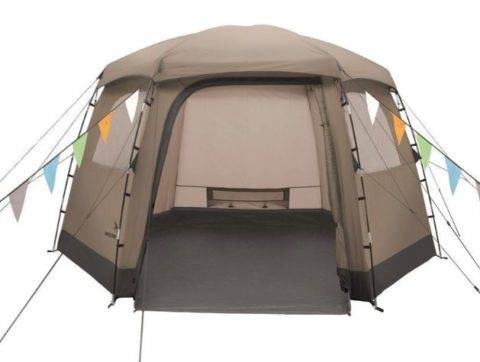
Yurts can make for a great alternative to tents when it comes to camping. And since they were traditionally used by nomadic tribes, they are meant to be used with transportation in mind.
That said, they are nowhere near as compact as a tent. Tents have been created specifically for the purpose of camping, whereas yurts can be both homes as well as a place for the community to come together. All of this means that yurts offer more space and a lot more options for comfort compared to tents. They are also much larger, accommodating a longer list of amenities.
Keep in mind that just because there is more space, it doesn’t mean that you are going to be lugging all this extra stuff around. That said, it is nice to know that you can bring a little more than you would if you had a tent.
Some of the more permanent camping yurts will offer a much more luxurious camping experience while not quite feeling that you are sacrificing being so close to nature as you would in something like a cabin or hotel. These are the type of yurts that are becoming quite popular within the glamping community.
Also, depending on the size, yurts have the potential to accommodate things like comfortable beds, separate rooms, kitchens, bathrooms, and can even have electricity. There are even some yurts that can fit up to 15 people comfortably, making them ideal for camping with a larger group.
Another thing that makes them so great is that they can take anywhere from 30 minutes to three hours to set up. It all depends on the size as well as how many people you have to help you put the structure up.
Most modern portable yurts can be built or taken down within an hour. That’s longer than the average tent, but given all the space and comfort that comes with the yurt, it is more than worth the tradeoff.
Yurts are also designed with the elements and environment in mind. When the weather is cooler, it will keep you warm. In the summer, it can definitely help you to stay cool. The round shape means that there is less surface area to be exposed to those outside elements.
Yurts can also provide less wind resistance since the wind will move around the curved parts rather than catching on the straight edges of a tent. They are able to stand up to strong winds, snow, and even something extreme like earthquakes.
Ultimately, yurts can provide a fun alternative to traditional tent camping while also adding comfort and a touch of glam to the equation. There is a ton of space inside, and you can be certain that you will be protected from the elements.
Just be sure that you are comfortable with the loss of flexibility and the extra time that comes with their construction. For longer camping trips, they would make for an excellent home base.
What Should You Know Before Purchasing a Yurt?
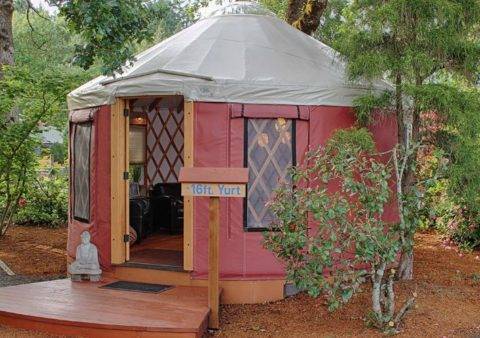
There are a few matters of importance to keep in mind when choosing a yurt. First and foremost is the size of the yurt. Because they come in so many different dimensions, there are a seemingly endless array of options to choose from.
Yurts can range from roughly 12’ in diameter (or 115 square feet) all the way up to 30’ (706 square feet). That allows a lot of room for customization and changes to be made. It all depends on how you plan to use your yurt.
If you are going to use it for camping purposes, going with a smaller yurt is probably the best option. It will give you greater luxury than you would get with a tent but not so many options that you will lose the portability factor.
If you are looking to make the move to tiny home living, then a yurt can be a great option. There are a variety of floor plans available that can help you determine what items, like furniture, you’ll want to have in your yurt.
Yurts are measured by diameter, and the standard kit will include things like rafters, doors, windows, a center ring, lattice walls, hardware, and the top cover. All to allow for the easy construction of your yurt.

